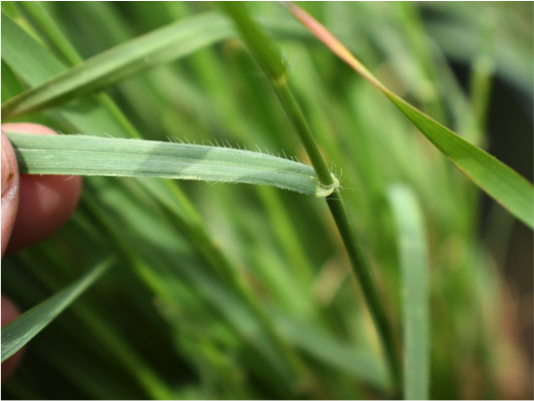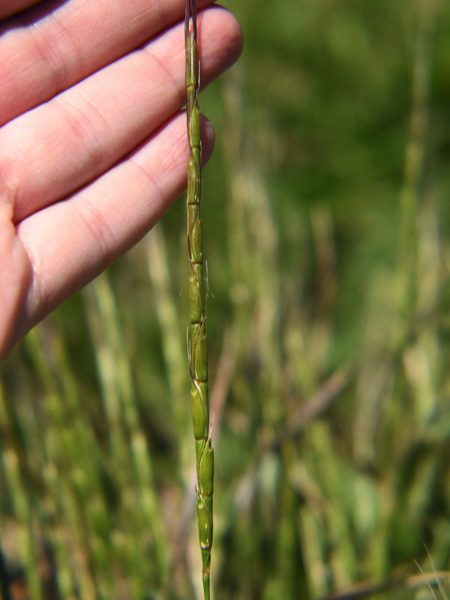Farmers at some recent wheat plot tours noted that jointed goatgrass seems to be more prevalent than usual this spring. This World of Weeds feature will discuss this weedy relative of wheat, also know as joint goatgrass
Ecology
Jointed goatgrass is a winter annual that germinates roughly the same time as winter wheat and the rate of development of the two species is similar throughout the growing season. It is native to southern Europe and is thought to have been introduced in Kansas during the 1900s as a contaminant in imported wheat. It can be found in a variety of habitats, including roadsides, rights of ways, and fields throughout much on the United States, including all of Kansas.
Jointed goatgrass is frequently observed in wheat fields. Research suggests it can cause approximately 27% yield loss when 2 plants per square foot emerge at the same time as wheat, with less yield loss when jointed goatgrass emerges later. Additional research conducted in growth chambers suggests that jointed goatgrass is more competitive than winter wheat in high temperature/low water scenarios, while it is less competitive than wheat under favorable growing conditions. Jointed goatgrass seeds are similar in size to wheat seeds, making it very difficult to separate, and contributing to its spread throughout wheat-producing regions. Jointed goatgrass can also serve as an alternate host for Russian wheat aphids, wheat curl mites, and several fungal diseases that attack winter wheat.
Identification
Jointed goatgrass seedlings have a sparsely hairy leaf blade, with stiff hairs that stick out from the leaf margin, a pubescent sheath margin, a short membraneous ligule, and small auricles (Figure 1).

Figure 1. Jointed goatgrass leaf margin and collar region. Note stiff hairs on the leaf, short ligule, and small auricles. Photo by Sarah Lancaster, K-State Research and Extension.
Mature plants can be up to 24 inches tall. Stems are hairless and have a bend at the lower nodes. Leaf blades are less than 1/4 inch wide and can reach up to 5 inches long. The inflorescence is a narrow spike 2 to 4 inches long. The spike is distinctly segmented into 5 to 10 cylindrical spikelets (also called joints). Each spikelet is about 1/3 to 1/2 inch long and may have an awn that is about 1/4 to 1/3 inch long (Figure 2). One or two seeds can be found in each spikelet, and typically do not thresh free from the chaff. The spikelet can be used to identify small seedlings as they emerge in the spring.

Figure 2. Jointed goatgrass spike. Note cylindrical joints with awns. Photo by Sarah Lancaster, K-State Research and Extension.
Management
Multiple tactics are needed to effectively manage jointed goatgrass. Jointed goatgrass seed longevity is reported to be about 3 to 5 years, so long crop rotations are one cultural practice that can help manage the weed. Research conducted in Kansas, Nebraska, and Wyoming suggests that increasing the seeding rate of wheat can reduce jointed goatgrass seed production in some environments.
Other examples of cultural control that may be effective, especially when combined, include selecting taller cultivars and delaying wheat planting. In addition, because jointed goatgrass seed readily germinates from the soil surface, tillage can be a helpful management tool. Unpublished research from Colorado and Oklahoma suggests that moldboard plowing can result in greater control and less seed production compared to sweep plowing or disking.
Herbicide options for jointed goatgrass control are limited. Glyphosate is effective in fallow periods or in glyphosate-resistant crops. However, herbicide-resistant wheat varieties are the only effective options for jointed goatgrass control in wheat. Imazamox (Beyond) can be used in Clearfield wheat varieties, and quizalofop (Aggressor) can be used in CoAxium wheat varieties.
The use of trade names is for clarity to readers and does not imply endorsement of a particular product, nor does exclusion imply non-approval. Always consult the herbicide label for the most current use requirements. For more detailed information, see the “2022 Chemical Weed Control for Field Crops, Pastures, and Noncropland” guide available online at https://www.bookstore.ksre.ksu.edu/pubs/CHEMWEEDGUIDE.pdf or check with your local K-State Research and Extension office for a paper copy.
Sarah Lancaster, Extension Weed Management Specialist
Tags: wheat weed control World of Weeds